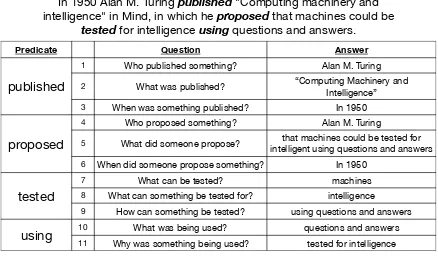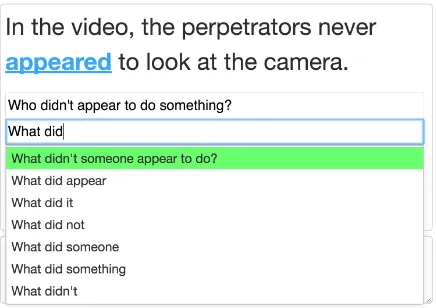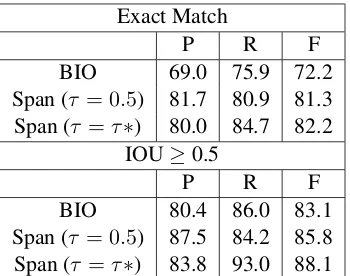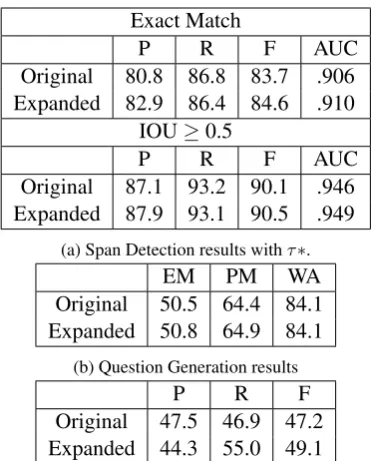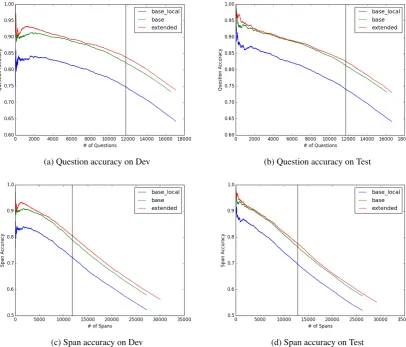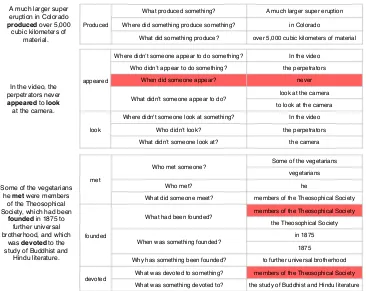2051
Large-Scale QA-SRL Parsing
Nicholas FitzGerald∗ Julian Michael∗ Luheng He Luke Zettlemoyer∗
Paul G. Allen School of Computer Science and Engineering University of Washington, Seattle, WA
{nfitz,julianjm,luheng,lsz}@cs.washington.edu
Abstract
We present a new large-scale corpus of Question-Answer driven Semantic Role Labeling (QA-SRL) annotations, and the first high-quality QA-SRL parser. Our cor-pus, QA-SRL Bank 2.0, consists of over 250,000 question-answer pairs for over 64,000 sentences across 3 domains and was gathered with a new crowd-sourcing scheme that we show has high precision and good recall at modest cost. We also present neural models for two QA-SRL subtasks: detecting argument spans for a predicate and generating questions to label the semantic relationship. The best models achieve question accuracy of 82.6% and span-level accuracy of 77.6% (under hu-man evaluation) on the full pipelined QA-SRL prediction task. They can also, as we show, be used to gather additional annota-tions at low cost.
1 Introduction
Learning semantic parsers to predict the predicate-argument structures of a sentence is a long standing, open challenge (Palmer et al., 2005; Baker et al., 1998). Such systems are typically trained from datasets that are difficult to gather,1 but recent research has explored training non-experts to provide this style of semantic supervi-sion (Abend and Rappoport, 2013; Basile et al., 2012;Reisinger et al.,2015;He et al., 2015). In this paper, we show for the first time that it is pos-sible to go even further by crowdsourcing a large
∗
Much of this work was done while these authors were at the Allen Institute for Artificial Intelligence.
1The PropBank (Bonial et al.,2010) and FrameNet ( Rup-penhofer et al.,2016) annotation guides are 89 and 119 pages, respectively.
In 1950 Alan M. Turing published "Computing machinery and intelligence" in Mind, in which he proposed that machines could be
tested for intelligence using questions and answers.
Predicate Question Answer
published
1 Who published something? Alan M. Turing
2 What was published? “Computing Machinery and Intelligence”
3 When was something published? In 1950
proposed
4 Who proposed something? Alan M. Turing
5 What did someone propose? intelligent using questions and answersthat machines could be tested for
6 When did someone propose something? In 1950
tested
7 What can be tested? machines 8 What can something be tested for? intelligence 9 How can something be tested? using questions and answers
using 1011 What was being used? questions and answers
[image:1.595.307.526.224.353.2]Why was something being used? tested for intelligence
Figure 1: An annotated sentence from our dataset. Question 6 was not produced by crowd workers in the initial collection, but was produced by our parser as part of Data Expansion (seeSection 5.)
scale dataset that can be used to train high quality parsers at modest cost.
We adopt the Question-Answer-driven Seman-tic Role Labeling (QA-SRL) (He et al., 2015) annotation scheme. QA-SRL is appealing be-cause it is intuitive to non-experts, has been shown to closely match the structure of tra-ditional predicate-argument structure annotation schemes (He et al., 2015), and has been used for end tasks such as Open IE (Stanovsky and Dagan, 2016). In QA-SRL, each predicate-argument re-lationship is labeled with a question-answer pair (seeFigure 1). He et al.(2015) showed that high precision QA-SRL annotations can be gathered with limited training but that high recall is chal-lenging to achieve; it is relatively easy to gather answerable questions, but difficult to ensure that every possible question is labeled for every verb. For this reason, they hired and trained hourly an-notators and only labeled a relatively small dataset (3000 sentences).
en-sure high precision (i.e. all the questions must be answerable). With this approach, we produce QA-SRL Bank 2.0, a dataset with 133,479 verbs from 64,018 sentences across 3 domains, total-ing 265,140 question-answer pairs, in just 9 days. Our analysis shows that the data has high preci-sion with good recall, although it does not cover every possible question. Figure1shows example annotations.
Using this data, our second contribution is a comparison of several new models for learning a QA-SRL parser. We follow a pipeline approach where the parser does (1) unlabeledspan detection to determine the arguments of a given verb, and (2) question generation to label the relationship be-tween the predicate and each detected span. Our best model uses a span-based representation sim-ilar to that introduced byLee et al. (2016) and a custom LSTM to decode questions from a learned span encoding. Our model does not require syn-tactic information and can be trained directly from the crowdsourced span labels.
Experiments demonstrate that the model does well on our new data, achieving up to 82.2% span-detection F1 and 47.2% exact-match question ac-curacy relative to the human annotations. We also demonstrate the utility of learning to predict easily interpretable QA-SRL structures, using a simple data bootstrapping approach to expand our dataset further. By tuning our model to favor recall, we over-generate questions which can be validated us-ing our annotation pipeline, allowus-ing for greater recall without requiring costly redundant annota-tions in the question writing step. Performing this procedure on the training and development sets grows them by 20% and leads to improvements when retraining our models. Our final parser is highly accurate, achieving 82.6% question accu-racy and 77.6% span-level precision in an human evaluation. Our data, code, and trained models will be made publicly available.2
2 Data Annotation
A QA-SRL annotation consists of a set of question-answer pairs for each verbal predicate in a sentence, where each answer is a set of contigu-ous spans from the sentence. QA-SRL questions are defined by a 7-slot template shown inTable 1. We introduce a crowdsourcing pipeline to collect annotations rapidly, cheaply, and at large scale.
[image:2.595.308.526.70.224.2]2http://qasrl.org
Figure 2: Interface for the generation step. Auto-complete shows completions of the current QA-SRL slot, and auto-suggest shows fully-formed questions (highlighted green) based on the previ-ous questions.
Pipeline Our crowdsourcing pipeline consists of a generation andvalidation step. In the genera-tion step, a sentence with one of its verbs marked is shown to a single worker, who must write QA-SRL questions for the verb and highlight their an-swers in the sentence. The questions are passed to the validation step, where n workers answer each question or mark it asinvalid. In each step, no two answers to distinct questions may overlap with each other, to prevent redundancy.
Instructions Workers are instructed that avalid question-answer pair must satisfy three criteria: 1) the question is grammatical, 2) the question-answer pair is asking about the time, place, par-ticipants, etc., of the target verb, and 3) all correct answers to each question are given.
Autocomplete We provide an autocomplete
Wh Aux Subj Verb Obj Prep Misc
Who blamed someone
What did someone blame something on
Who refused to do something
When did someone refuse to do something
Who might put something somewhere
[image:3.595.161.440.63.132.2]Where might someone put something
Table 1: Example QA-SRL questions, decomposed into their slot-based representation. See He et al. (2015) for the full details. All slots draw from a small, deterministic set of options, including verb tense (present,pastparticiple, etc.) Here we have replaced the verb-tense slot with its conjugated form.
Wikipedia Wikinews Science Sentences 15,000 14,682 46,715
Verbs 32,758 34,026 66,653
Questions 75,867 80,081 143,388
Valid Qs 67,146 70,555 127,455
Table 2: Statistics for the dataset with questions written by workers across three domains.
Payment and quality control Generation pays 5c for the first QA pair (required), plus 5c, 6c, etc. for each successive QA pair (optional), to boost recall. The validation step pays 8c per verb, plus a 2c bonus per question beyond four. Generation workers must write at least 2 questions per verb and have 85% of their questions counted valid, and validators must maintain 85% answer span agree-ment with others, or they are disqualified from further work. A validator’s answer is considered to agree with others if their answer span overlaps with answer spans provided by a majority of work-ers.
Preprocessing We use the Stanford CoreNLP
tools (Manning et al.,2014) for sentence segmen-tation, tokenizing, and POS-tagging. We identify verbs by POS tag, with heuristics to filter out aux-iliary verbs while retaining non-auxaux-iliary uses of “have” and “do.” We identify conjugated forms of each verb for the QA-SRL templates by finding them in Wiktionary.3
Dataset We gathered annotations for 133,479 verb mentions in 64,018 sentences (1.27M tokens) across 3 domains: Wikipedia, Wikinews, and sci-ence textbook text from the Textbook Question Answering (TQA) dataset (Kembhavi et al.,2017). We partitioned the source documents into train, dev, and test, sampled paragraph-wise from each document with an 80/10/10 split by sentence.
Annotation in our pipeline with n = 2
valida-3www.wiktionary.org
tors took 9 days on Amazon Mechanical Turk.4 1,165 unique workers participated, annotating a total of 299,308 questions. Of these, 265,140 (or 89%) were considered valid by both validators, for an average of 1.99 valid questions per verb and 4.14 valid questions per sentence. SeeTable 2for a breakdown of dataset statistics by domain. The total cost was $43,647.33, for an average of 32.7c per verb mention, 14.6c per question, or 16.5c per valid question. For comparison, He et al.(2015) interviewed and hired contractors to annotate data at much smaller scale for a cost of about 50c per verb. Our annotation scheme is cheaper, far more scalable, and provides more (though noisier) su-pervision for answer spans.
To allow for more careful evaluation, we vali-dated 5,205 sentences at a higher density (up to 1,000 for each domain in dev and test), re-running the generated questions through validation with
n= 3for a total of 6 answer annotations for each question.
Quality Judgments of question validity had
moderate agreement. About 89.5% of validator judgments rated a question as valid, and the agree-ment rate between judgagree-ments of the same ques-tion on whether the quesques-tion is invalid is 90.9%. This gives a Fleiss’s Kappa of 0.51. In the higher-density re-run, validators were primed to be more critical: 76.5% of judgments considered a ques-tion valid, and agreement was at 83.7%, giving a Fleiss’s Kappa of 0.55.
Despite being more critical in the denser anno-tation round, questions marked valid in the origi-nal dataset were marked valid by the new annota-tors in 86% of cases, showing our data’s relatively high precision. The high precision of our annota-tion pipeline is also backed up by our small-scale manual evaluation (see Coverage below).
Answer spans for each question also exhibit
[image:3.595.87.280.203.253.2]P R F He et al.(2015) 97.5 86.6 91.7
This work 95.7 72.4 82.4
[image:4.595.77.286.61.119.2]This work (unfiltered) 94.9 85.4 89.9
Table 3: Precision and recall of our annotation pipeline on a merged and validated subset of 100 verbs. The unfiltered number represents relaxing the restriction that none of 2 validators marked the question as invalid.
good agreement. On the original dataset, each an-swer span has a 74.8% chance to exactly match one provided by another annotator (up to two), and on the densely annotated subset, each answer span has an 83.1% chance to exactly match one pro-vided by another annotator (up to five).
Coverage Accurately measuring recall for QA-SRL annotations is an open challenge. For exam-ple, question 6 inFigure 1reveals an inferred tem-poral relation that would not be annotated as part of traditional SRL. Exhaustively enumerating the full set of such questions is difficult, even for ex-perts.
However, we can compare to the original QA-SRL dataset (He et al., 2015), where Wikipedia sentences were annotated with 2.43 questions per verb. Our data has lower—but loosely comparable—recall, with 2.05 questions per verb in Wikipedia.
In order to further analyze the quality of our annotations relative to (He et al.,2015), we rean-notate a 100-verb subset of their data both manu-ally (aiming for exhaustivity) and with our crowd-sourcing pipeline. We merge the three sets of annotations, manually remove bad questions (and their answers), and calculate the precision and re-call of the crowdsourced annotations and those of He et al.(2015) against this pooled, filtered dataset (using the span detection metrics described in Sec-tion 4). Results, shown in Table 3, show that our pipeline produces comparable precision with only a modest decrease in recall. Interestingly, re-adding the questions rejected in the validation step greatly increases recall with only a small decrease in precision, showing that validators sometimes rejected questions considered valid by the authors. However, we use the filtered dataset for our ex-periments, and inSection 5, we show how another crowdsourcing step can further improve recall.
3 Models
Given a sentence X = x0, . . . , xn, the goal of
a QA-SRL parser is to produce a set of tuples
(vi,Qi,Si), where v ∈ {0, . . . , n} is the index
of a verbal predicate,Qi is a question, andSi ∈ {(i, j)|i, j∈[0, n], j≥i}is a set of spans which are valid answers. Our proposed parsers construct these tuples in a three-step pipeline:
1. Verbal predicates are identified using the same POS-tags and heuristics as in data col-lection (see Section2).
2. Unlabeled span detectionselects a setSv of
spans as arguments for a given verbv. 3. Question generation predicts a question for
each span inSv. Spans are then grouped by
question, giving each question a set of an-swers.
We describe two models for unlabeled span de-tection in section 3.1, followed by question gen-eration in section3.2. All models are built on an LSTM encoding of the sentence. LikeHe et al. (2017), we start with an inputXv ={x0. . .xn},
where the representation xi at each time step is
a concatenation of the tokenwi’s embedding and
an embedded binary feature (i = v) which indi-cates whether wi is the predicate under
consid-eration. We then compute the output representa-tionHv = BILSTM(Xv)using a stacked
alter-nating LSTM (Zhou and Xu,2015) with highway connections (Srivastava et al., 2015) and recur-rent dropout (Gal and Ghahramani,2016). Since the span detection and question generation mod-els both use an LSTM encoding, this component could in principle be shared between them. How-ever, in preliminary experiments we found that sharing hurt performance, so for the remainder of this work each model is trained independently.
3.1 Span Detection
Given an encoded sentenceHv, the goal of span
detection is to select the spansSv that correspond
to arguments of the given predicate. We explore two models: a sequence-tagging model with BIO encoding, and a span-based model which assigns a probability to every possible span.
3.1.1 BIO Sequence Model
Our BIO model predicts a set of spans via a se-quencey where eachyi ∈ {B,I,O},
(2017), we make independent predictions for each token at training time, and use Viterbi decoding to enforce hard BIO-constraints5 at test time. The resulting sequences are in one-to-one correspon-dence with sets Sv of spans which are pairwise
non-overlapping. The locally-normalized BIO-tag distributions are computed from the BiLSTM out-putsHv ={hv0, . . . ,hvn}:
p(yt|x)∝exp(w|tagMLP(hvt) +btag) (1)
3.1.2 Span-based Model
Our span-based model makes independent binary decisions for allO(n2)spans in the sentence. Fol-lowing Lee et al. (2016), the representation of a span (i, j) is the concatenation of the BiLSTM output at each endpoint:
svij = [hvi,hvj]. (2)
The probability that the span is an argument of predicatevis computed by the sigmoid function:
p(yij |Xv) =σ(w|spanMLP(svij) +bspan) (3)
At training time, we minimize the binary cross en-tropy summed over alln2possible spans, counting
a span as a positive example if it appears as an an-swer to any question.
At test time, we choose a threshold τ and se-lect every span that the model assigns probability greater than τ, allowing us to trade off precision and recall.
3.2 Question Generation
We introduce two question generation models. Given a span representation svij defined in sub-subsection 3.1.2, our models generate questions by picking a word for each question slot (see Sec-tion 2). Each model calculates a joint distribuSec-tion
p(y |Xv,svij)over valuesy = (y1, . . . , y7)for
the question slots given a spansvij, and is trained
to minimize the negative log-likelihood of gold slot values.
3.2.1 Local Model
The local model predicts the words for each slot independently:
p(yk|Xv,svij)∝exp(w|kMLP(svij) +bk).
(4)
5E.g., anI-tag should only follow aB-tag.
3.2.2 Sequence Model
The sequence model uses the machinery of an RNN to share information between slots. At each slotk, we apply a multiple layers of LSTM cells:
hl,k,cl,k=LSTMCELLl,k(hl−1,k,hl,k−1,cl,k−1)
(5) where the initial input at each slot is a concate-nation of the span representation and the embed-ding of the previous word of the question:h0,k =
[svij;yk−1]. Since each question slot predicts
from a different set of words, we found it bene-ficial to use separate weights for the LSTM cells at each slotk. During training, we feed in the gold token at the previous slot, while at test time, we use the predicted token. The output distribution at slot k is computed via the final layers’ output vectorhLk:
p(yk|Xv,svij)∝exp(w|kMLP(hLk) +bk)
(6)
4 Initial Results
Automatic evaluation for QA-SRL parsing presents multiple challenges. In this section, we introduce automatic metrics that can help us compare models. In Section 6, we will report human evaluation results for our final system.
4.1 Span Detection
Metrics We evaluate span detection using a
modified notion of precision and recall. We count predicted spans as correct if they match any of the labeled spans in the dataset. Since each pre-dicted span could potentially be a match to multi-ple questions (due to overlapping annotations) we map each predicted span to one matching question in the way that maximizes measured recall using maximum bipartite matching. We use both exact match and intersection-over-union (IOU) greater than 0.5 as matching criteria.
Results Table 4shows span detection results on the development set. We report results for the span-based models at two threshold valuesτ:τ = 0.5, andτ = τ∗ maximizing F1. The span-based model significantly improves over the BIO model in both precision and recall, although the differ-ence is less pronounced under IOU matching.
4.2 Question Generation
Exact Match
P R F
BIO 69.0 75.9 72.2
Span (τ = 0.5) 81.7 80.9 81.3 Span (τ =τ∗) 80.0 84.7 82.2
IOU≥0.5
P R F
BIO 80.4 86.0 83.1
[image:6.595.95.270.61.199.2]Span (τ = 0.5) 87.5 84.2 85.8 Span (τ =τ∗) 83.8 93.0 88.1
Table 4: Results for Span Detection on the dense development dataset. Span detection results are given with the cutoff threshold τ at 0.5, and at the value which maximizes F-score. The top chart lists precision, recall and F-score with exact span match, while the bottom reports matches where the intersection over union (IOU) is≥0.5.
EM PM SA
Local 44.2 62.0 83.2 Seq. 47.2 62.3 82.9
Table 5: Question Generation results on the dense development set.EM- Exact Match accuracy,PM
- Partial Match Accuracy,SA- Slot-level accuracy
the fact that there are in general multiple possi-ble valid questions for a given predicate-argument pair. For instance, the question “Who did some-one blame something on?” may be rephrased as “Who was blamed for something?” However, due to the constrained space of possible questions de-fined by QA-SRL’s slot format, accuracy-based metrics can still be informative. In particular, we report the rate at which the predicted question ex-actly matches the gold question, as well as a re-laxed match where we only count the question word (WH), subject (SBJ), object (OBJ) and Mis-cellaneous (Misc) slots (seeTable 1). Finally, we report average slot-level accuracy.
Results Table 5shows the results for question generation on the development set. The sequen-tial model’s exact match accuracy is significantly higher, while word-level accuracy is roughly com-parable, reflecting the fact that the local model learns the slot-level posteriors.
[image:6.595.305.516.62.106.2]4.3 Joint results
Table 6shows precision and recall for joint span detection and question generation, using exact
P R F
Span + Local 37.8 43.7 40.6 Span + Seq. (τ = 0.5) 39.6 45.8 42.4
Table 6: Joint span detection and question gener-ation results on the dense development set, using exact-match for both spans and questions.
match for both. This metric is exceedingly hard, but it shows that almost 40% of predictions are exactly correct in both span and question. In Sec-tion 6, we use human evaluaSec-tion to get a more ac-curate assessment of our model’s accuracy.
5 Data Expansion
Since our trained parser can produce full QA-SRL annotations, its predictions can be validated by the same process as in our original annotation pipeline, allowing us to focus annotation efforts towards filling potential data gaps.
By detecting spans at a low probability cutoff, we over-generate QA pairs for already-annotated sentences. Then, we filter out QA pairs whose answers overlap with answer spans in the ing annotations, or whose questions match exist-ing questions. What remains are candidate QA pairs which fill gaps in the original annotation. We pass these questions to the validation step of our crowdsourcing pipeline withn= 3validators, re-sulting in new labels.
We run this process on the training and devel-opment partitions of our dataset. For the develop-ment set, we use the trained model described in the previous section. For the training set, we use a relaxed version of jackknifing, training 5 models over 5 different folds. We generate 92,080 ques-tions at a threshold ofτ = 0.2. Since in this case many sentences have only one question, we re-structure the pay to a 2c base rate with a 2c bonus per question after the first (still paying no less than 2c per question).
[image:6.595.117.246.318.361.2]ex-Exact Match
P R F AUC
Original 80.8 86.8 83.7 .906 Expanded 82.9 86.4 84.6 .910
IOU≥0.5
P R F AUC
Original 87.1 93.2 90.1 .946 Expanded 87.9 93.1 90.5 .949
(a) Span Detection results withτ∗.
EM PM WA
Original 50.5 64.4 84.1 Expanded 50.8 64.9 84.1
(b) Question Generation results
P R F
Original 47.5 46.9 47.2 Expanded 44.3 55.0 49.1
(c) Joint span detection and question generation results with
[image:7.595.88.274.59.290.2]τ= 0.5
Table 7: Results on the expanded development set comparing the full model trained on the original data, and with the expanded data.
panded development set whose answer spans have two overlaps with the answer spans of one ques-tion in the original annotaques-tions. After this filtering, the expanded development set we use for evalua-tion has 11.5% more quesevalua-tions than the original development set.
The total cost including MTurk fees was $8,210.66, for a cost of 8.9c per question, or 17.8c per valid question. While the cost per valid ques-tion was comparable to the initial annotaques-tion, we gathered many more negative examples (which may serve useful in future work), and this method allowed us to focus on questions that were missed in the first round and improve the exhaustiveness of the annotation (whereas it is not obvious how to make fully crowdsourced annotation more ex-haustive at a comparable cost per question).
Retrained model We retrained our final model on the training set extended with the new valid questions, yielding modest improvements on both span detection and question generation in the de-velopment set (see Table 7). The span detection numbers are higher than on the original dataset, because the expanded development data captures true positives produced by the original model (and the resulting increase in precision can be traded off for recall as well).
6 Final Evaluation
We use the crowdsourced validation step to do a final human evaluation of our models. We test 3 parsers: the span-based span detection model paired with each of the local and sequential question generation models trained on the initial dataset, and our final model (span-based span de-tection and sequential question generation) trained with the expanded data.
Methodology On the 5,205 sentence densely
annotated subset of dev and test, we generate QA-SRL labels with all of the models using a span detection threshold of τ = 0.2 and combine the questions with the existing data. We filter out questions that fail the autocomplete grammatical-ity check (counting them invalid) and pass the data into the validation step, annotating each question to a total of 6 validator judgments. We then com-pute question and span accuracy as follows: A question is considered correct if 5 out of 6 anno-tators consider it valid, and a span is considered correct if its generated question is correct and the span is among those selected for the question by validators. We rank all questions and spans by the threshold at which they are generated, which al-lows us to compute accuracy at different levels of recall.
Results Figure 3shows the results. As expected, the sequence-based question generation models are much more accurate than the local model; this is largely because the local model generated many questions that failed the grammaticality check. Furthermore, training with our expanded data re-sults in more questions and spans generated at the same threshold. If we choose a threshold value which gives a similar number of questions per sen-tence as were labeled in the original data annota-tion (2 quesannota-tions / verb), quesannota-tion and span accu-racy are 82.64% and 77.61%, respectively.
Table 8shows the output of our best system on 3 randomly selected sentences from our develop-ment set (one from each domain). The model was overall highly accurate—only one question and 3 spans are considered incorrect, and each mistake is nearly correct,6even when the sentence contains a negation.
6The incorrect question “When did someone appear?”
(a) Question accuracy on Dev (b) Question accuracy on Test
[image:8.595.91.498.75.422.2](c) Span accuracy on Dev (d) Span accuracy on Test
Figure 3: Human evaluation accuracy for questions and spans, as each model’s span detection threshold is varied. Questions are considered correct if 5 out of 6 annotators consider it valid. Spans are considered correct if their question was valid, and the span was among those labeled by human annotators for that question. The vertical line indicates a threshold value where the number of questions per sentence matches that of the original labeled data (2 questions / verb).
7 Related Work
Resources and formalisms for semantics often require expert annotation and underlying syntax (Palmer et al.,2005;Baker et al.,1998;Banarescu et al., 2013). Some more recent semantic re-sources require less annotator training, or can be crowdsourced (Abend and Rappoport, 2013; Reisinger et al.,2015;Basile et al.,2012;Michael et al., 2018). In particular, the original QA-SRL (He et al., 2015) dataset is annotated by free-lancers, while we developed streamlined crowd-sourcing approaches for more scalable annotation. Crowdsourcing has also been used for indirectly annotating syntax (He et al., 2016; Duan et al., 2016), and to complement expert annotation of SRL (Wang et al.,2018). Our crowdsourcing ap-proach draws heavily on that of Michael et al.
(2018), with automatic two-stage validation for the collected question-answer pairs.
More recently, models have been developed for these newer semantic resources, such as UCCA (Teichert et al., 2017) and Semantic Proto-Roles (White et al., 2017). Our work is the first high-quality parser for QA-SRL, which has several unique modeling challenges, such as its highly structured nature and the noise in crowdsourcing.
Produced
What produced something? A much larger super eruption
Where did something produce something? in Colorado
What did something produce? over 5,000 cubic kilometers of material A much larger super
eruption in Colorado produced over 5,000
cubic kilometers of material.
appeared
Where didn’t someone appear to do something? In the video
Who didn’t appear to do something? the perpetrators
When did someone appear? never
What didn’t someone appear to do?
look at the camera
to look at the camera
look
Where didn't someone look at something? In the video
Who didn’t look? the perpetrators
What didn’t someone look at? the camera In the video, the
perpetrators never appeared to look
at the camera.
met
Who met someone? Some of the vegetarians vegetarians
Who met? he
What did someone meet? members of the Theosophical Society
founded
What had been founded? members of the Theosophical Society the Theosophical Society
When was something founded? in 1875 1875
Why has something been founded? to further universal brotherhood
devoted
What was devoted to something? members of the Theosophical Society
What was something devoted to? the study of Buddhist and Hindu literature Some of the vegetarians
he met were members of the Theosophical Society, which had been
founded in 1875 to further universal brotherhood, and which
was devoted to the study of Buddhist and
[image:9.595.117.483.59.350.2]Hindu literature.
Table 8: System output on 3 randomly sampled sentences from the development set (1 from each of the 3 domains). Spans were selected withτ = 0.5. Questions and spans with a red background were marked incorrect during human evaluation.
8 Conclusion
In this paper, we demonstrated that QA-SRL can be scaled to large datasets, enabling a new methodology for labeling and producing predicate-argument structures at a large scale. We presented a new, scalable approach for crowd-sourcing QA-SRL, which allowed us to collect QA-SRL Bank 2.0, a new dataset covering over 250,000 question-answer pairs from over 64,000 sentences, in just 9 days. We demonstrated the utility of this data by training the first parser which is able to produce high-quality QA-SRL struc-tures. Finally, we demonstrated that the validation stage of our crowdsourcing pipeline, in combina-tion with our parser tuned for recall, can be used to add new annotations to the dataset, increasing recall.
Acknowledgements
The crowdsourcing funds for QA-SRL Bank 2.0 was provided by the Allen Institute for Artificial Intelligence. This research was supported in part by the ARO (W911NF-16-1-0121) the NSF (IIS-1252835, IIS-1562364), a gift from Amazon, and
an Allen Distinguished Investigator Award. We would like to thank Gabriel Stanovsky and Mark Yatskar for their helpful feedback.
References
Omri Abend and Ari Rappoport. 2013. Universal con-ceptual cognitive annotation (UCCA). InACL 2013.
Collin F Baker, Charles J Fillmore, and John B Lowe. 1998. The Berkeley Framenet project. In ICCL 1998.
Laura Banarescu, Claire Bonial, Shu Cai, Madalina Georgescu, Kira Griffitt, Ulf Hermjakob, Kevin Knight, Philipp Koehn, Martha Palmer, and Nathan Schneider. 2013. Abstract meaning representation for sembanking. In7th Linguistic Annotation Work-shop and Interoperability with Discourse.
Valerio Basile, Johan Bos, Kilian Evang, and Noortje Venhuizen. 2012. Developing a large semantically annotated corpus. InLREC 2012.
Claire Bonial, Olga Babko-Malaya, Jinho D Choi, Jena Hwang, and Martha Palmer. 2010. Propbank anno-tation guidelines.
Manjuan Duan, Ethan Hill, and Michael White. 2016. Generating disambiguating paraphrases for struc-turally ambiguous sentences. In10th Linguistic An-notation Workshop.
Nicholas FitzGerald, Oscar T¨ackstr¨om, Kuzman Ganchev, and Dipanjan Das. 2015. Semantic role labeling with neural network factors. In EMNLP 2015.
Yarin Gal and Zoubin Ghahramani. 2016. A theoret-ically grounded application of dropout in recurrent neural networks. InNIPS 2016.
Luheng He, Kenton Lee, Omer Levy, and Luke Zettle-moyer. 2018. Jointly predicting predicates and ar-guments in neural semantic role labeling. InACL 2018.
Luheng He, Kenton Lee, Mike Lewis, and Luke Zettle-moyer. 2017. Deep semantic role labeling: What works and whats next. InACL 2017.
Luheng He, Mike Lewis, and Luke S. Zettlemoyer. 2015. Question-answer driven semantic role label-ing: Using natural language to annotate natural lan-guage. InEMNLP 2015.
Luheng He, Julian Michael, Mike Lewis, and Luke Zettlemoyer. 2016. Human-in-the-loop parsing. In
EMNLP 2016.
Aniruddha Kembhavi, Minjoon Seo, Dustin Schwenk, Jonghyun Choi, Ali Farhadi, and Hannaneh Ha-jishirzi. 2017. Are you smarter than a sixth grader? textbook question answering for multimodal ma-chine comprehension. InCVPR 2017.
Kenton Lee, Luheng He, Mike Lewis, and Luke S. Zettlemoyer. 2017. End-to-end neural coreference resolution. InEMNLP 2017.
Kenton Lee, Shimi Salant, Tom Kwiatkowski, Ankur Parikh, Dipanjan Das, and Jonathan Berant. 2016. Learning recurrent span representations for ex-tractive question answering. arXiv preprint arXiv:1611.01436.
Christopher Manning, Mihai Surdeanu, John Bauer, Jenny Finkel, Steven Bethard, and David McClosky. 2014. The stanford corenlp natural language pro-cessing toolkit. InACL 2014, pages 55–60.
Julian Michael, Gabriel Stanovsky, Luheng He, Ido Dagan, and Luke Zettlemoyer. 2018. Crowdsourc-ing question-answer meanCrowdsourc-ing representations. In
NAACL 2018.
Martha Palmer, Daniel Gildea, and Paul Kingsbury. 2005. The proposition bank: An annotated corpus of semantic roles. Computational Linguistics.
Drew Reisinger, Rachel Rudinger, Francis Ferraro, Craig Harman, Kyle Rawlins, and Benjamin Van Durme. 2015. Semantic proto-roles.TACL.
Josef Ruppenhofer, Michael Ellsworth, Miriam RL Petruck, Christopher R Johnson, and Jan Schef-fczyk. 2016. FrameNet II: Extended theory and practice. Institut f¨ur Deutsche Sprache, Bibliothek.
Rupesh K Srivastava, Klaus Greff, and J¨urgen Schmid-huber. 2015. Training very deep networks. InNIPS 2015.
Gabriel Stanovsky and Ido Dagan. 2016. Creating a large benchmark for open information extraction. In
EMNLP 2016.
Swabha Swayamdipta, Sam Thomson, Chris Dyer, and Noah A Smith. 2017. Frame-semantic parsing with softmax-margin segmental rnns and a syntactic scaf-fold.arXiv preprint arXiv:1706.09528.
Adam R Teichert, Adam Poliak, Benjamin Van Durme, and Matthew R Gormley. 2017. Semantic proto-role labeling. InAAAI 2017, pages 4459–4466.
Chenguang Wang, Alan Akbik, Laura Chiticariu, Yun-yao Li, Fei Xia, and Anbang Xu. 2018. Crowd-in-the-loop: A hybrid approach for annotating semantic roles. InEMNLP 2017.
Aaron Steven White, Kyle Rawlins, and Benjamin Van Durme. 2017. The semantic proto-role linking model. InACL 2017.
Bishan Yang and Tom Mitchell. 2017. A joint sequen-tial and relational model for frame-semantic parsing. InEMNLP 2017, pages 1247–1256.
